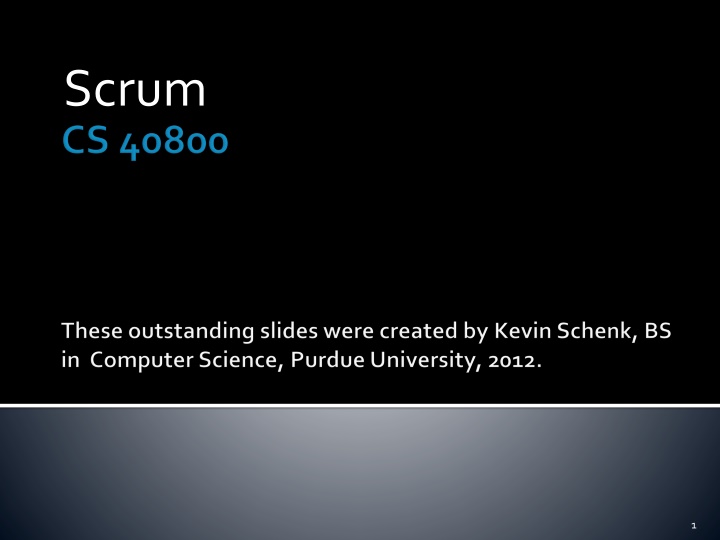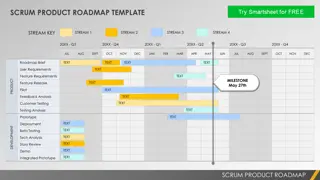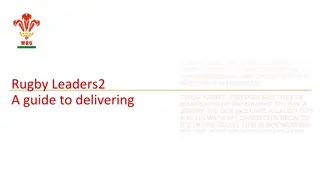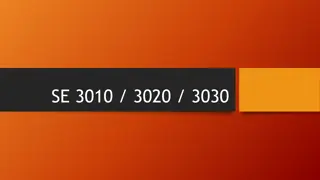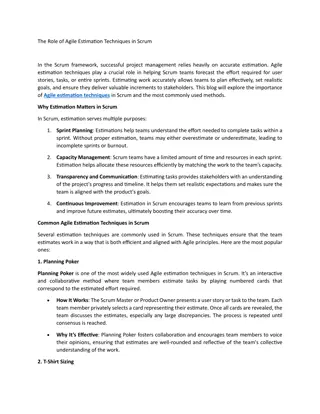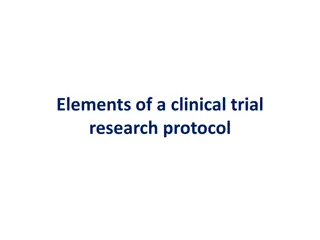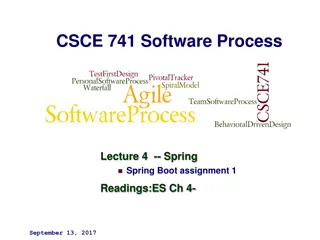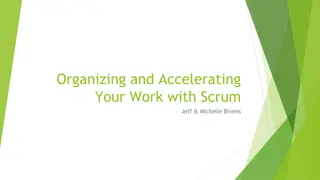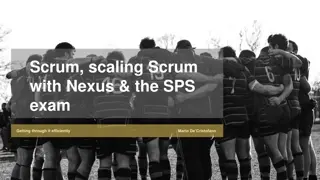The Key Elements of Scrum Methodology
Explore the roles, events, artifacts, and core concepts of Scrum, including the responsibilities of Product Owners and Scrum Masters, the composition of Development Teams, the significance of Sprints, and the iterative nature of product development within the framework.
Download Presentation

Please find below an Image/Link to download the presentation.
The content on the website is provided AS IS for your information and personal use only. It may not be sold, licensed, or shared on other websites without obtaining consent from the author.If you encounter any issues during the download, it is possible that the publisher has removed the file from their server.
You are allowed to download the files provided on this website for personal or commercial use, subject to the condition that they are used lawfully. All files are the property of their respective owners.
The content on the website is provided AS IS for your information and personal use only. It may not be sold, licensed, or shared on other websites without obtaining consent from the author.
E N D
Presentation Transcript
Scrum 1
Roles Events Artifacts Product Owner Scrum Master Development Team Sprint Sprint Planning Daily Scrum Sprint Review Sprint Retrospective Project Charter Product Backlog Sprint Backlog Burn down chart 2
Roles Events Artifacts Product Owner Scrum Master Development Team Sprint Sprint Planning Daily Scrum Sprint Review Sprint Retrospective Product Backlog Sprint Backlog 3
Defines the features of the product Decides on release date and content Prioritizes features according to market value Adjusts features and priority every iteration, as needed Accepts or rejects work results 4
Represents management to the project Responsible for enacting Scrum values and practices Removes impediments Ensures that the team is fully functional Enables close cooperation across all roles and functions Shields the team from external interferences 5
Members are cross-functional, with all of the skills as a team necessary to create a product Programmers, user experience designers, testers, business analysts, etc. Members have no titles other than Developer , regardless of the work being performed by the person Members may have specialized skills and areas of focus, but accountability belongs to the team as a whole Teams do not contain sub-teams dedicated to particular domains like testing or business analysis. Optimal team size: 4-9 members 6
Roles Events Artifacts Product Owner Scrum Master Development Team Sprint Sprint Planning Daily Scrum Sprint Review Sprint Retrospective Product Backlog Sprint Backlog 7
Considered the heart of Scrum A sprint is a time-box of one month or less (usually between 2-4 weeks) during which a Done, useable, and potentially releasable product increment is created. Sprints have consistent durations throughout a development effort. A new Sprint starts immediately after the conclusion of the previous Sprint. During the Sprint: No changes are made that would affect the Sprint Goal Development Team composition remains constant Quality goals do not decrease Scope may be clarified and re-negotiated between the Product Owner and Development Team as more is learned 8
A Sprint Planning Meeting is a meeting where the work to be performed in the sprint is planned. Usually time-boxed to eight hours for a one-month sprint. For shorter sprints, the event is proportionately shorter. There are two parts to the meeting: What will be delivered in this Sprint? How will the work get done? 9
The Product Owner presents ordered list of all items needed to be completed to the Development Team The entire Scrum Team collaborates on understanding the work of the sprint. Other items are evaluated before making a decision: Product Backlog The latest product Increment (or Iteration) Projected capacity of the Development Team for the upcoming Sprint Past performance of the Development Team A Sprint Goal, or an objective that will be met within the Sprint, is defined during this meeting. 10
The Development Team decides how it will build this functionality into a Done product Increment during the Sprint The Product Backlog items selected for this Sprint plus the plan for delivering them is called the Sprint Backlog. The Development Team self-organizes the Sprint Backlog by estimating the time it will take to complete each item and assigning tasks to individual team members 11
The Daily Scrum (or Stand-up Meeting) is a 15-minute time-boxed event for the Development Team to synchronize activities and create a plan for the next 24 hours. The Daily Scrum is held at the same time and place each day to reduce complexity. Each team member answers three questions: What has been accomplished since the last meeting? What will be done before the next meeting? What obstacles are in the way? 12
Improves communications Eliminates other meetings Identifies and removes impediments to development Highlights and promotes quick decision-making Improves the Development Team s level of project knowledge. 13
The Sprint Review Meeting is the time when the Development Team presents what it accomplished during the sprint Takes the form of a demo of new features or concrete progress Informal and requires little prep time The entire team participates 14
The Sprint Retrospective is an opportunity for the Scrum Team to reflect and create a plan for improvements to be enacted during the next Sprint. The purpose: Think about how the last Sprint went with regards to people, relationships, process, and tools Identify and order the major items that went well and potential improvements Create a plan for implementing improvements to the way the Scrum Team does its work All team members have the opportunity to answer: What went well during the last sprint? What didn t go well during the last sprint? How should the team improve for the next sprint? 15
Roles Events Artifacts Product Owner Scrum Master Development Team Sprint Sprint Planning Daily Scrum Sprint Review Sprint Retrospective Project Charter Product Backlog Sprint Backlog Burn down chart 16
Problem Statement: Short and succinct (one or two sentences) Project Objectives: What the project will achieve Stakeholders: Persons who will be actively involved with the project (e.g. project sponsor, types of users, etc.) Project Deliverables: The major results or services that will be produced, what are the specific things the software will do 17
The Product Backlog is an ordered list of everything that might be needed in the product and is the single source of Requirements for any changes to be made to the product. The Product Owner is responsible for the Product Backlog, including its content, availability, and ordering. A Product Backlog is never complete. Lists all features, functions, requirements, enhancements, and fixes that constitute the changes to be made to the product in future releases. 18
Backlog Item Estimate Allow a guest to make a reservation. 3 As a guest, I want to cancel a reservation. 5 As a guest, I want to change the dates of a reservation. 3 As an admin, I would like to change the availability of dates at my hotel. 8 Improve exception handling. 8 Backlog items are usually in the form of: As a ______, I want to ________ so that I can _______. Product Backlog items are sometimes called user stories 19
In a Sprint Backlog, the Development Team selects items from the product backlog they can commit to completing in a given sprint. The team then identifies tasks to complete these and each is estimated (1-16 hours to complete). Program the Back-End (8 hours) Program the Front-End (4 hours) As a travel planner, I would like to see the reviews of each hotel. Write Test Cases (4 hours) Make Database Changes (2 hours) Update Dependent Pages (3 hours) User Story Sprint Backlog Items 20
Individuals sign up for work of their own choosing Work is never assigned Estimated work remaining is updated daily Any team member can add to, delete from, or modify the sprint backlog Work for the sprint emerges If work is unclear, define a sprint backlog item with a larger amount of time and break it down later Update work remaining as more becomes known 21
Backlog Tasks Mon Tue Wed Thur Fri Program the Back-End 3 4 1 Program the Front-End 2 2 Write Test Cases 3 1 Make Database Changes 2 Update Dependent Pages 3 22
Roles Events Artifacts Product Owner Scrum Master Development Team Sprint Sprint Planning Daily Scrum Sprint Review Sprint Retrospective Project Charter Product Backlog Sprint Backlog Burn down chart 23
TEAM Defines the features of the product Decides on release date and content Prioritizes features according to market value Adjusts features and priority every iteration, as needed PROJECT COORDINATOR Accepts or rejects work results 24
TEAM LEADER Represents management to the project Responsible for enacting Scrum values and practices Removes impediments Ensures that the team is fully functional Enables close cooperation across all roles and functions Shields the team from external interferences 25
You will be using a modified version of SCRUM on your project. It will consist of two Sprints: (Sprint 1) Develop a Project Charter (What the software will do) by Friday, Jan 24 (Sprint 1) Develop a Product Backlog (Requirements Document) and Test Plan by Friday, Jan 31 (Sprint 1) Do Design Inspection, Code Inspection, and Unit Testing by Friday, Feb 7 (Sprint 1) Do Integration Testing, Regression Testing, and complete software development by Friday, Feb 14 (Sprint 2) Do Design Inspection, Code Inspection, and Unit Testing by Friday, Feb 21 (Sprint 2) Do Integration Testing, Regression Testing, and complete software development by Friday, Feb 28 Project demo, Mar 3-7 26
Have a Sprint Planning Meeting (1-2 hours long) by Friday, Jan 31 27
During your software development and testing time interval, have a "Daily Scrum" 2-3 times per week at the same time and place 28
The Sprint 1 Review Meeting should be in the week of Feb 3-7 You are encouraged to have a Sprint 1 Retrospective Meeting after Friday, Feb 14 The Sprint 2 Review Meeting should be in the week of Mar 3-7 29
